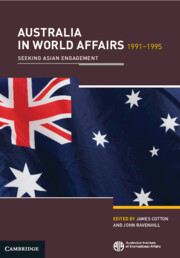Book contents
- Frontmatter
- Contents
- Tables
- Abbreviations
- Contributors
- Preface
- 1 Australia’s ‘Engagement with Asia’
- 2 An Overview
- 3 The Rhetoric of Asia
- 4 Australia and Asia: A View From Europe
- 5 Australia’s Defence Policies in the Post–Cold War Era
- 6 Australia, Disarmament and Arms Control
- 7 Australia and the World Economy 1991–95: Closer Economic Integration with Asia?
- 8 Australia and the International Environment
- 9 Australia and Japan
- 10 Australia and Southeast Asia
- 11 Australia and China, 1991–95: Asymmetry and Congruence in the Post–Cold War Era
- 12 Australia and the Four Asian Dragons: Beyond the Economic Agenda?
- 13 Reassessed: Australia’s Relationship with the United States
- 14 Australia and the European Union
- 15 Australian Relations with the Former Communist States of Europe and the Soviet Union
- 16 Australia and New Zealand: Unequal Partners on the Periphery
- 17 Australia and the South Pacific: The Rationalist Ascendancy
- Notes
- Index
16 - Australia and New Zealand: Unequal Partners on the Periphery
Published online by Cambridge University Press: 04 May 2024
- Frontmatter
- Contents
- Tables
- Abbreviations
- Contributors
- Preface
- 1 Australia’s ‘Engagement with Asia’
- 2 An Overview
- 3 The Rhetoric of Asia
- 4 Australia and Asia: A View From Europe
- 5 Australia’s Defence Policies in the Post–Cold War Era
- 6 Australia, Disarmament and Arms Control
- 7 Australia and the World Economy 1991–95: Closer Economic Integration with Asia?
- 8 Australia and the International Environment
- 9 Australia and Japan
- 10 Australia and Southeast Asia
- 11 Australia and China, 1991–95: Asymmetry and Congruence in the Post–Cold War Era
- 12 Australia and the Four Asian Dragons: Beyond the Economic Agenda?
- 13 Reassessed: Australia’s Relationship with the United States
- 14 Australia and the European Union
- 15 Australian Relations with the Former Communist States of Europe and the Soviet Union
- 16 Australia and New Zealand: Unequal Partners on the Periphery
- 17 Australia and the South Pacific: The Rationalist Ascendancy
- Notes
- Index
Summary
The trans-Tasman relationship matured in the 1990s as Australia and New Zealand assumed somewhat more distinct identities, while simultaneously forging a closer partnership on the periphery of the Asia-Pacific region. No one in New Zealand pretends that the relationship with Australia is one of equals. Each is a central but asymmetrical priority for the other in economic, trade, foreign and security policies. The momentous global changes of the 1990s affected the two countries in similar ways and produced many similar responses. Along with the abatement of the Soviet threat from Southeast and North Asia, this gave rise to some fears of the retrenchment of the United States from Asia and to a resulting instability in Asia. Australian and New Zealand concerns therefore focused more sharply on the creation of structures of confidence building and security dialogues in the Asia-Pacific region. Yet New Zealand’s geopolitical distance from Asia relative to that of Australia, as well as New Zealand’s dissociation from the Australia, New Zealand and United States (ANZUS) security alliance for fears of nuclear contamination, took Canberra and Wellington along some separate defence paths.
Keywords
- Type
- Chapter
- Information
- Australia in World Affairs 1991–1995Seeking Asian Engagement, pp. 193 - 210Publisher: Cambridge University PressFirst published in: 2024



